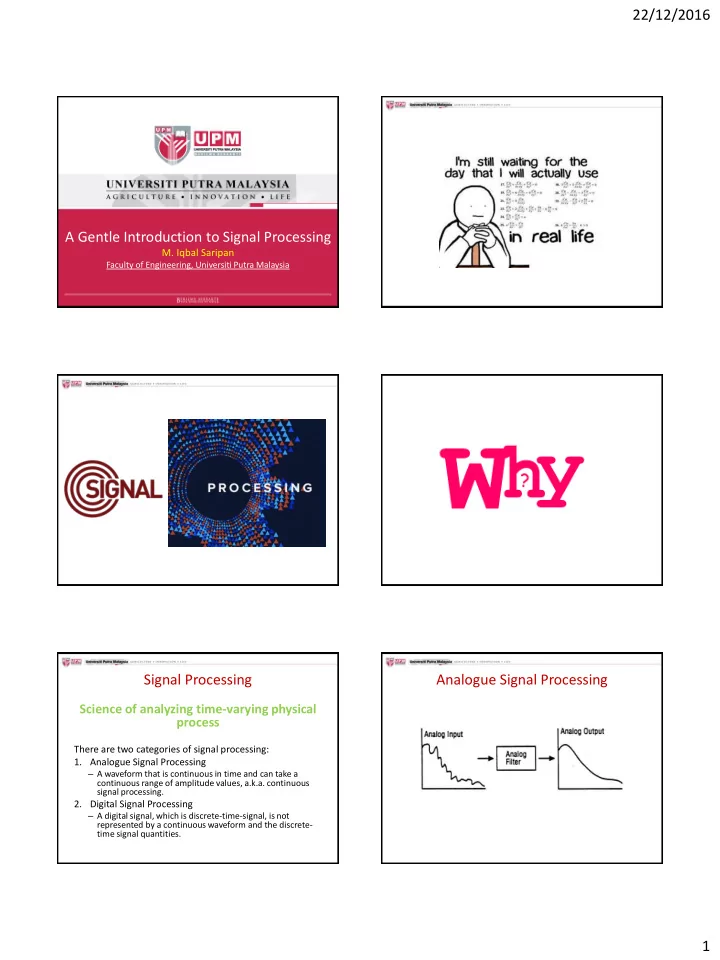

22/12/2016 A Gentle Introduction to Signal Processing M. Iqbal Saripan Faculty of Engineering, Universiti Putra Malaysia Signal Processing Analogue Signal Processing Science of analyzing time-varying physical process There are two categories of signal processing: 1. Analogue Signal Processing – A waveform that is continuous in time and can take a continuous range of amplitude values, a.k.a. continuous signal processing. 2. Digital Signal Processing – A digital signal, which is discrete-time-signal, is not represented by a continuous waveform and the discrete- time signal quantities. 1
22/12/2016 ADC Digital Signal Processing • Sampling Digital Signal A/D D/A Digital Analog Processor Digital Analog Converter Converter I/P Signal O/P Signal I/P Signal O/P Signal • Quantization Limitations of Digital Signal Processing Benefits: Digital Signal Processing over Analogue Signal Processing • Speed of operation of digital processors 1. Flexibility of the system offered by the • Noise due to sampling and quantization (ADC) software component 2. Better control of accuracy requirements, i.e. no problem with external effects 3. Ease of storage and offline processing 4. Lower cost of processors 5. Compression and coding techniques are efficient to implement DSP in STEM DSP As Enabling Technology (Texas) 2
22/12/2016 Examples of DSP Technology • Telecommunication • Echo Location – Multiplexing – Sonar – Compression – Radar – Echo Control – Reflection Seismology • Audio Processing • Image Processing – Music – Camera – Speech generation – Medical – Speech recognition – Satellite Multimedia Applications JPEG • Compression: Fast, efficient, reliable 43K 13K 3.5K transmission and storage of data • Applied on audio, image and video data for transmission over the Internet, storage • Examples: CDs, DVDs, MP3, MPEG4, JPEG • JPEG uses Discrete-Cosine Transform (similar to Fourier Transform) Biological Signal Analysis • Brain waves are usually contaminated by • Examples: noise and hard to interpret – Brain signals (EEG) – Cardiac signals (ECG) – Medical images (x-ray, PET, MRI) • Goals: – Detect abnormal activity (heart attack, seizure) – Help physicians with diagnosis 3
22/12/2016 Biometrics Audio Signal Processing • Active noise cancellation:Adaptive filtering • Identifying a person using physiological – Headphones used in cockpits characteristics • Digital Audio Effects • Examples: – Add special music effects such as delay, echo, – Fingerprint Identification reverb – Face Recognition • Audio signal separation – Voice Recognition – Separate speech from interference – Wind sound from music in cars Major Areas in DSP • Filtering New Algorithms in DSP Filters • Adaptive • Filters are signal conditioners • Multi-rate • Filter functions by accepting an input signal, • Mixed Analogue/Digital blocking prespecified frequency components and passing the original signal minus those • Non-linear components to the output. 4
22/12/2016 Digital Filters Convolution • Lowpass- Allows only low frequency signals to its outputs. • Highpass-Allows only high frequency signals to its outputs. • Bandpass-Allows only output signals within its narrow, government-authorized range of frequency spectrum. • Bandstop-Allows both low and high frequencies, but blocks a predefined range of frequencies. Programmable DSPs (P-DSP) 2. The Processor Architecture – There are mainly two types of architecture of The P-DSPs are specially designed for digital signal microprocessor: processing application. The main components of P- Von Neumann Architecture DSPs are: – In this architecture a single address bus and a single data bus for accessing the programme as well as data memory 1. Multiplier & Multiplier Accumulator (MAC) area. – It requires array multiplication. The multiplication as well as accumulating to be carried out using hardware Processing elements by two ways: Unit • A dedicated MAC unit implemented in hardware which has integrated multiplier and accumulator in a single hardware unit. • Use of multiplier and accumulator separately. Data and Program Control Unit Memory Harvard Architecture – Separate buses for the programme and data memory Processing Data Memory Unit Program Control Unit Memory 5
22/12/2016 Future of Signal Processing (Texas) Evolution of DSP Chip (Texas) DSP Chip for the Future • Very low power • High speed operation • Reconfigurable processor • Customizable processor • DSP chip with multiple integer and floating point MACs Disclaimer: All contents of this presentation are a compilation of publicly available information in the web. The data were published by either the publicly available presentation or publicly available statistical information (e.g. Texas, Bell Lab, etc.). No data are my own data. 6
Recommend
More recommend